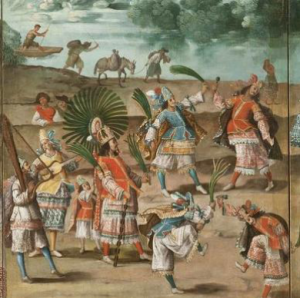Aztec, Spanish Cultures Intertwine At LA County Museum Of Art
 “Contested Visions in the Spanish Colonial World,” a current exhibit at the Los Angeles County Museum of Art, represents an intricately choreographed dialogue between several players in pre-Columbian history. Primarily, the exhibit examines two of the largest empires in the pre-Columbian world: Inca and Mexica (or Aztec), through the artifacts they left behind. But the exhibit also traffics in depictions of the arrival of Cortés and Pizzaro by Spanish artisans.
“Contested Visions in the Spanish Colonial World,” a current exhibit at the Los Angeles County Museum of Art, represents an intricately choreographed dialogue between several players in pre-Columbian history. Primarily, the exhibit examines two of the largest empires in the pre-Columbian world: Inca and Mexica (or Aztec), through the artifacts they left behind. But the exhibit also traffics in depictions of the arrival of Cortés and Pizzaro by Spanish artisans.
So, viewers can expect to see a fuscia feathered, Incan ceremonial coca leaf satchel alongside a 15th century Mixtec mask of gorgeous turquoise stones.
Artifacts from both cultures are displayed simultaneously; there is no “us” and “them” designation. The viewer is allowed to understand the prowess of power that made them empires without losing sight they were both inhabitants of América. The exhibit also exudes the comparative splendor that occurs when institutes collaborate and allow curators free reign to render our understanding of the past. All in all, the exhibit contains approximately 200 objects: paintings, sculptures, codices, manuscripts, queros (ceremonial drinking vessels), and featherworks. The exhibit’s strength, however, comes from the levels and layers and locus of pieces in the exhibit, and not necessarily the volume.
The emphasis “Contested Visions” places on unique and aesthetically-charged objects prompts viewers to look wisely. For example, the exhibit includes a sculpture of Xiuhtecuhtli, the Aztec god of fire and heat. The glass-encased sculpture, no taller than two feet and no wider than two feet, exudes a malevolent bent, enhanced, no doubt, by red-pigment accents on his fangs and portions of his headdress. Xiuhtecuhtli is often depicted as an old man, and something about the way it sat, arms-folded-on-knee, in the corner of the glass casing made him all the more menacing and memorable.
Moreover, the exhibit does not reduce the players in América’s history to conquered or conqueror; instead, because the artworks are embedded in their context, viewers can enjoy pieces aesthetically, while at the same time building meaning from the piece. Curated by Ilona Katzew, the department head of Latin American art at LACMA, the exhibit tenders six integral sections that explicate the social and political hierarchies inherent in the Aztec and Incan Empires. Eclectic to the core, the exhibit has a kid-in-a-candy-shop feel, but there is nothing childish about the resources of the partnering institute: the Mexican Institute of Anthropology and History, or Instituto Nacional de Antropología e Historia (INAH). Indeed, the collaboration creates a conversation in which the voices of all participants carry the same weight.
The exhibit is not anti-colonial, or pro-conquest. Emphasis rests on the importance and singularity of the object, and how well it serves to illustrate greater concepts of “cultural negotiation, mutual accommodation, and exchange, a dynamic that gave rise to vital works of art.” Curated in a way that allows each artifact to wield an influence, it seems as though Katzew took great pains to include long-forgotten artifacts that resonate with meaning. For example, there is an attractive Testerian catechism in the exhibit, a sequence of images that missionaries used to inculcate the idea of western religion into the belief system of indigenous peoples. Further on down the rabbit hole, there is an illustration of Tenochtitlán on the back of a folding screen from the 17th century next to an oil-on-canvas genealogy painting of a double wedding in the early 18th century.
Contested Visions ensures there’s room for multiple perspectives and ideologies.
[“Folding Screen with Indian Wedding and Flying Pole (detail)” Courtesy Los Angeles County Museum of Art]
